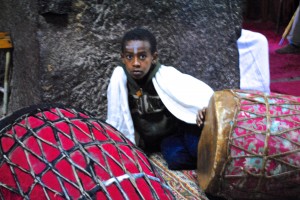We are traveling for about 5 days, not as storytellers but as tourists. It is said that if you go one place during your time in Ethiopia, it should be Lalibelia. Lalibelia is a town with a collection of 12th and 13th century churches that are carved out of rock, and still used today. We flew here with a friend we met on the road, and the 3 of us have been looking forward to our time around the churches, mostly due the hype built up by our tour guide books (locally called foreigners’ bibles). We went to see the first and most impressive batch of churches yesterday afternoon as soon as we arrived. Now I have to be honest, I was impressed with their beauty, but not blown away like the good-book Lonely Planet had said. Maybe we can just chalk it up to the food poisoning I am still suffering from 2 days later, or the long travel day. Whatever it was, it was not until we entered the largest of the churches the next morning for Sunday worship that the real beauty of this place really hit me. The worshipers were all dressed in white scarves and cloaks that they tie and fashion a hundred different ways. This clean and ancient looking attire, with the backdrop of the ancient earthy red buildings make you feel you have gone back in time about 1,000 years. Not much has changed with the religion or practice since the churches were first created, and it was a small girl who is turning 11 tomorrow who made me realize just how magical it was to be there.
Once we entered the church, I thought we would be gawked at and given the familiar finger shake I have grown accustomed to as I take photos around the country. Instead, I met this girl as I waited in a mass of people to get a glimpse of a 7kg gold cross that only comes out on Sundays. This little girl very sweetly asked where I was from and what my name was. I told her and asked her the same. She told me how konjono I am (compliments always accepted) and I repaid her the compliment and knew we would be friends. She asked if I liked the service and I told her of course I did. She took me to the different stations around the church and encouraged me to really look at them. There was a finely dressed priest offering the Lalibela cross (the seal of this region) to be kissed for a blessing. In the corners old women and children sat surrounded by their white scarves as they sat quietly and reflectively. Wandering around was another priest offering to place white ash on the foreheads of all who desired it. In the center, a half circle of priests and deacons chanted the Bible in the ancient language of Ge’ez, singing historical hymns and playing the traditional drums.
My new friend took me by the hand and we bounced from station to station. She was so excited to show me these things and to share this special place and culture with me. At one point she disappeared, and I made new young friends who were also eager to welcome me into their spiritual home and make sure I was comfortable. A few minutes later my first friend came back and she pulled my hand so I would bend down. She reached up to my forehead and placed the white ash on my head, smiling all along. Growing up, I went to Ash Wednesday services and had black ash placed on my head by pastors. It was always a nice evening that I enjoyed as a kid, but being blessed by a child stranger was quite konjono.






